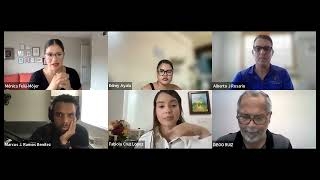Experts question Department of Health's inaction on COVID-19 and offer recommendations to improve public health response
Submitted by Mónica Ivelisse Feliú-Mójer on
A group of health professionals, scientists and physicians questioned the lack of action by the local Department of Health in the face of the high number of COVID-19 infections in Puerto Rico and offered specific recommendations to improve the public health response at this point in the pandemic. The statements were made during a press conference organized by the NGO and scientific collective Ciencia Puerto Rico (CienciaPR, www.cienciapr.org). A recording of the conference (in Spanish) can be accessed on Ciencia Puerto Rico's YouTube channel (https://youtu.be/jk8Qq2bpb4Q).
"Puerto Rico has had a high number of COVID-19 cases for almost two months. However, contrary to other occasions when we have seen sustained spikes in positivity, the Puerto Rico Department of Health (PRDH) has not taken forceful action to mitigate the number of infections. Instead, this time the emphasis has been on individual responsibility and not on protecting public health," said Edmy Ayala Rosado, community projects manager for CienciaPR and coordinator of its health, education and community project Aquí Nos Cuidamos (www.aquinoscuidamos.org).
Given this reality, the organization convened a panel of experts composed of epidemiologist Dr. Fabiola Cruz López, pediatric pulmonologist Dr. Brenda Mariola Rivera Reyes, primary care physician and epidemiologist Dr. Alberto Rosario, and infectious disease expert Dr. Marcos Ramos Benítez.
The group's remarks and recommendations focused on the need to implement infection prevention measures (such as the requirement to wear masks in enclosed spaces) and to educate on topics such as long COVID, antiviral treatments, and vaccination with boosters, among others.
About PRDH's emphasis on individual responsibility rather than prevention
"Right now, we are in the midst of a change in health strategy made abruptly, hastily and, as in most of the pandemic, without any explanation of why the decisions were made; nor what each change could mean [for people's health]," said Dr. Brenda Mariola Rivera Reyes, who is a pediatric pulmonologist and one of the leading expert voices on long CVID in Puerto Rico.
"I think we already understood that COVID-19 will not go away in the near future, and, as we colloquially say "we have to learn to live with it"; just like we live with other diseases. But the difference is that we always do our best not to get sick. The question is, right now, are we doing our best?", said researcher and infectious disease expert Dr. Marcos Ramos Benítez.
About the need to implement infection prevention measures
"We are certainly not suggesting that it is necessary to go back to the lockdowns, nor the restrictions of two years ago. However, given the current levels of COVID-19 transmission, which are almost as high as during the worst moments of the pandemic, we believe that strong and consistent preventive actions are necessary, such as reinstating the mask requirement in all enclosed spaces (as was done then) to prevent transmission. Without infection, there is no increase in cases, no new variants, no complications, and no persistent COVID. Nor do hospitalizations and deaths increase," said Dr. Mónica Feliú Mójer, director of communications for CienciaPR.
"A year ago our best and almost only tool to avoid hospitalizations and deaths from COVID-19 was to avoid infection. Today, we have other tools that protect most of the population. But it is a bit dangerous to believe that we don't have to do anything to avoid infection, because for every scenario there are exceptions," explained Dr. Ramos Benitez, founder and president of the Ciencia en tus manos educational project.
"We have two years of practice in establishing the use of masks in public places, encouraging things to be done outside or outdoors and not being in closed places. We have two years of practice in trying to keep distance in these places and, all of a sudden, we want to forget everything we learned, because we think that new tools can replace the gold standard, which is to avoid infection. So, in this context, avoiding infection is our best tool," the scientist added.
- Reinstate the use of facemasks in public and enclosed spaces until positivity is close to the contagion control target (3%).
- Prioritize public health education on:
- long COVID (what it is, how to get help and treatments);
- eligibility and access to treatment for COVID-19;
- the importance of preventive medicine;
- the importance of receiving a booster to keep vaccination up to date; and
- the importance of COVID-19 prevention and the risks of not taking preventive measures (infection, severe illness, persistent COVID, disability, hospitalization, death) especially for high-risk populations (people with chronic diseases, over 65).
- Resume publication of reports of different indicators relevant to the pandemic and use these to educate in a contextualized and up-to-date manner and to facilitate monitoring and improvement of the public health response.
- Collaborate with educational projects, community-based organizations, and other entities for broad and accessible education to different segments of the population, and for education to go beyond social networks.









